Cemeteries in Debrecen in the past
(graphics: Papp József)
After many decades of preparation, on July 15, 1932, "the public cemetery and the mortuary building in Debrecen were quietly handed over for use without any special solemnity."
(graphics: Papp József)
In Debrecen, the ancient cemeteries owned by the city, but managed by the denominations, were already "overcrowded" by the mid-19th century. Even then, the citizens of Debrecen had already taken the initiative to put them in order, but minor or major improvements could not offer a long-term solution. When, in 1897, all the cemeteries, which had previously been outlying cemeteries, were included in the areas that could be built on, a definitive solution to the cemetery issue became inevitable.
(graphics: Papp József)
The decision to establish a public cemetery in the city, independent of religious affiliation, was taken in 1909 by the Debrecen City Council. Although the national competition for this project in 1916 had a winner, the political and economic consequences of the World War meant that the public cemetery and the crematorium could not be built.
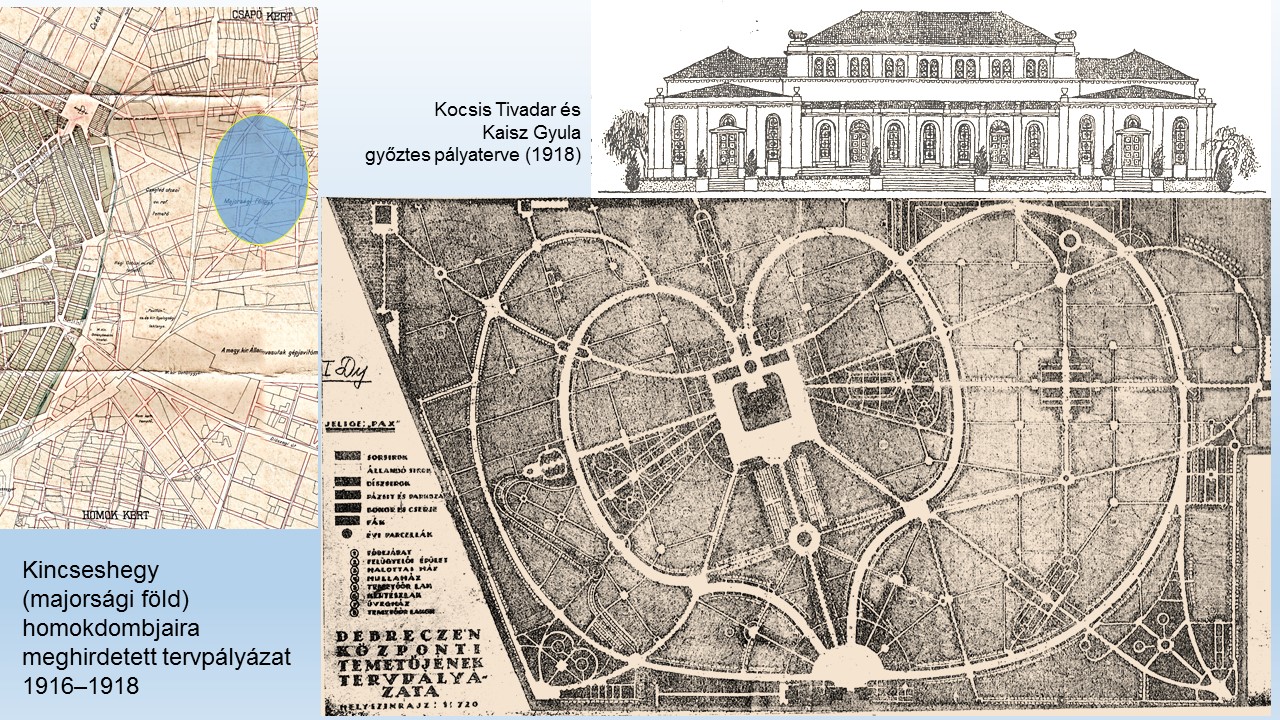
(edited: Papp József)
The issue of the funeral and the public cemetery was again brought before the town council in 1923. The different location, an area cut out of the pasture along the Hadházi highway and the forest cleared in the eastern part of the Nagyerdő, was approved in 1924, following proposals by Géza Aczél and later József Borsos. It was also stated that the entire project, from planning to the handing over of the keys, would be carried out by the professionals of the Mayor's Office.
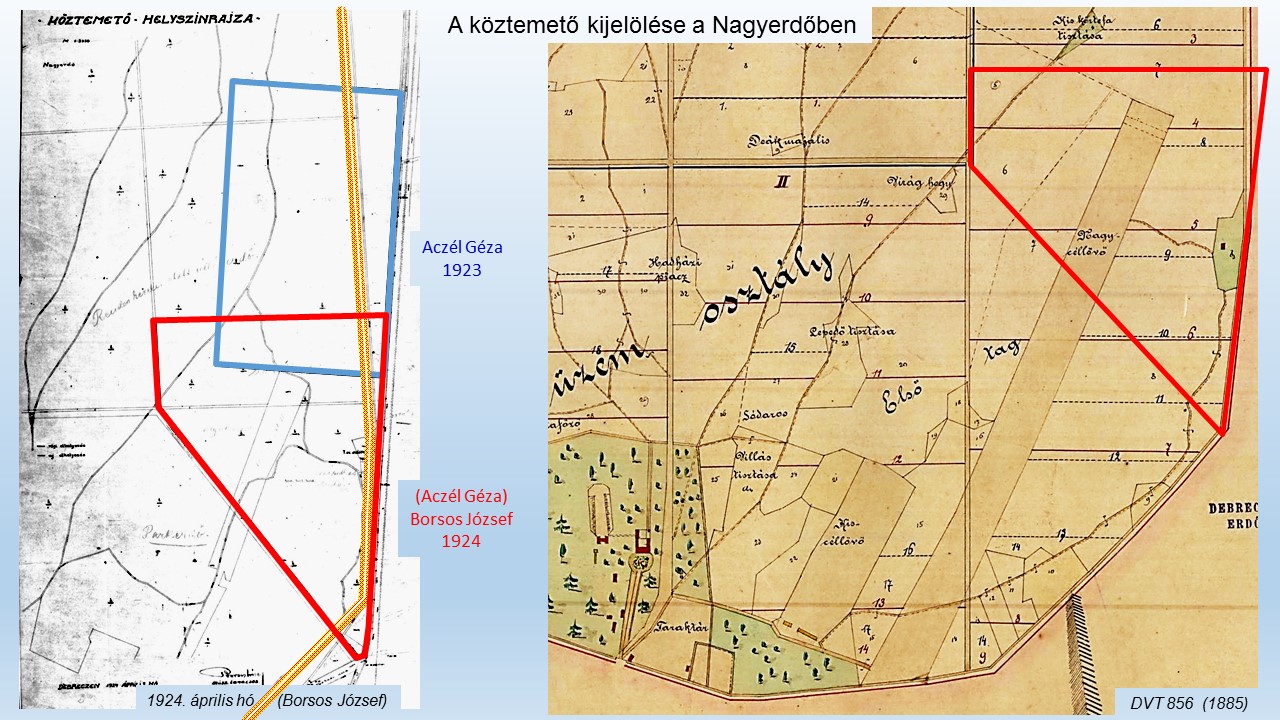
(graphics: Papp József)
Almost half of the forest sections designated for the facility were originally empty clearings. The remaining, relatively sparsely afforested areas were mainly composed of hundred-year-old oaks and, to a lesser extent, mixed trees (oak, elm, pear, maple, poplar) of three decades old.
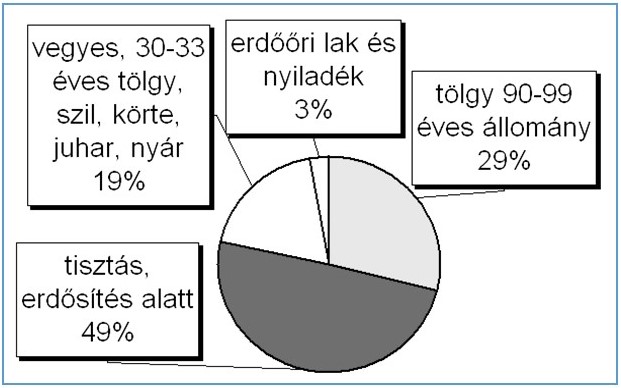
(graphics: Papp József)
First, the affected forest areas were taken out of forest management and reclassified as park forest, compensating the State Forestry Service, which managed the urban forests, by afforesting other areas. The forest ranger's dwelling, which had also been part of the cemetery and used for horticultural purposes, was replaced by a new one.
Landscaping and road construction began in 1925, and the encircling of the cemetery began in 1927. The planning and construction took place in parallel: The new forest guard apartment was already handed over to the forestry, when, in 1930, the funeral and cremation building, the main entrance, the guard houses and the horticultural building, as well as the detailed plan for the division of the cemetery and the budgets were presented to the general assembly. 150,000 from the so-called "big loan" and 350,000 pence from the sale of new housing plots in the area of the Kincseshegy and Kónya settlement, which was to be developed as a public cemetery, were earmarked as financial collateral. To cover the shortfall, a new loan was taken out, to be repaid from the future cemetery's revenues (grave shop and grave prices, use of the cemetery, etc.)
The forest cemetery is magnificent in its unity and detail. Its facilities have been located with relative sparing of the valuable tree population. The wide strip of former military firing range, which was already arable land at the turn of the century, provided an almost treeless site for the funeral home and the burial ground.
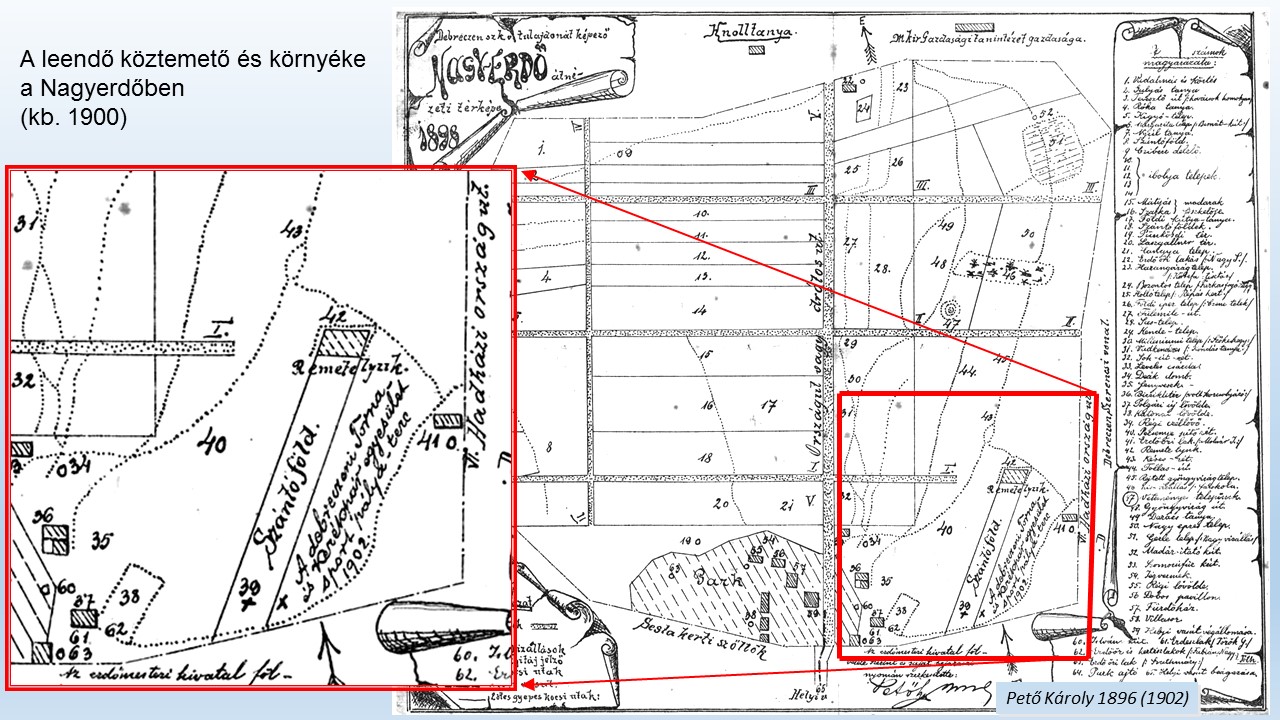
(edited: Papp József)
Under the supervision of the cemetery's horticultural designer, Ferenc Pohl, nearly 200,000 m2 of wild forest was cleared from 1930. The internal roads were designed according to the guidelines of József Borsos, architect and chief engineer of the town, who had dreamed up the cemetery and its buildings. "The forest cemetery is better suited to a winding, natural route, if only for the protection of the trees".
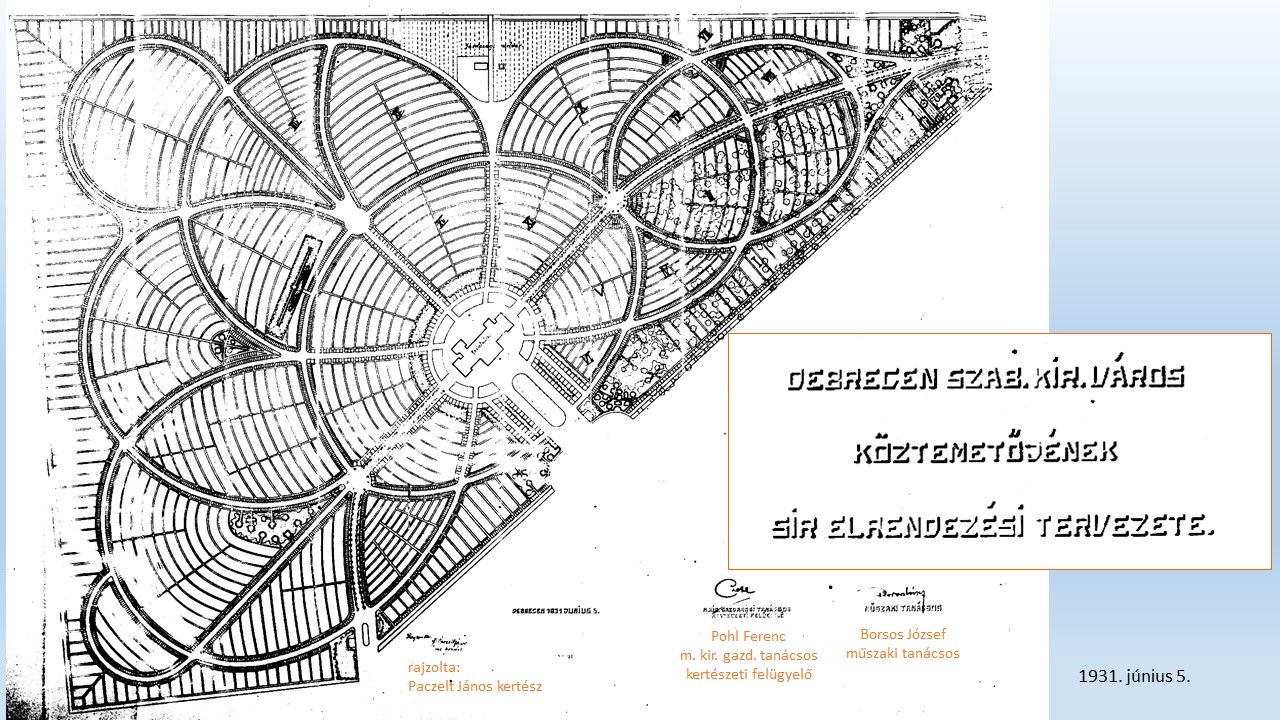
(edited: Papp József)
From the road, a 600 m long forest edge was created on the former pasture. On the inner main road leading from the cemetery entrance on Kassai Road to the funeral home, tree-lined areas were planted with 2 to 2 large groups of about 1,000 pine trees and about 400 shrub roses. An important aspect was the creation of a harmonious colour scheme of the plants, so that, for example, evergreens played a major role in the undergrowth to create a beautiful winter cemetery scene.
(edited: Papp József)
The funeral home and cremator, set in a woodland setting and transformed into a park with existing and planted plants, is perhaps the finest work of the architect József Borsos. Decorated with Hungarian folk style elements and solemn colours, the serious, soothing effect of the facility is doubled in the reflection of the 1000 m2 of calm water surface
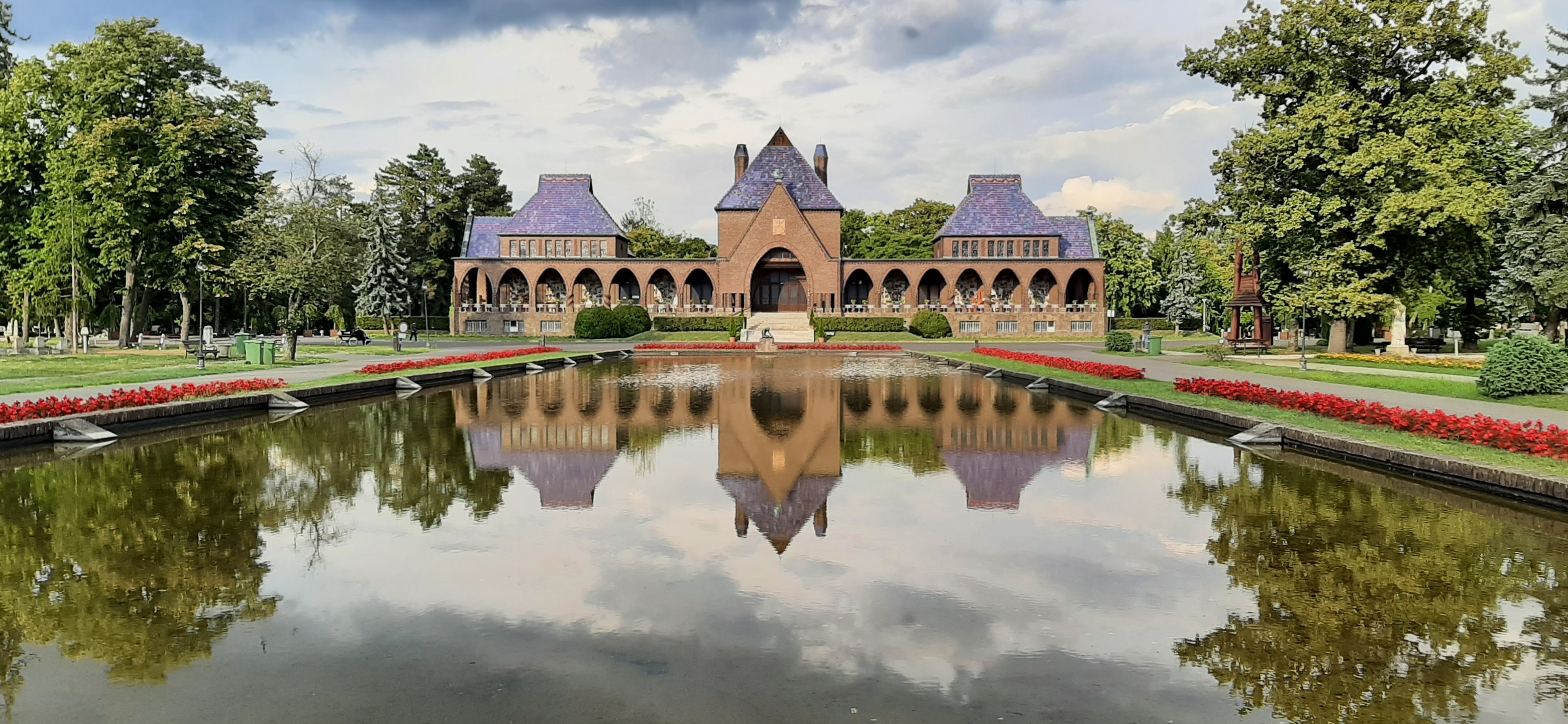
(photo: Papp József)
The designer achieved the building's festive appearance with carefully chosen colours of glazed brick and glazed tiles from Debrecen. The special effect is enhanced by the pillars of the main arcade of the funeral home's main façade, each of which has a different shape.
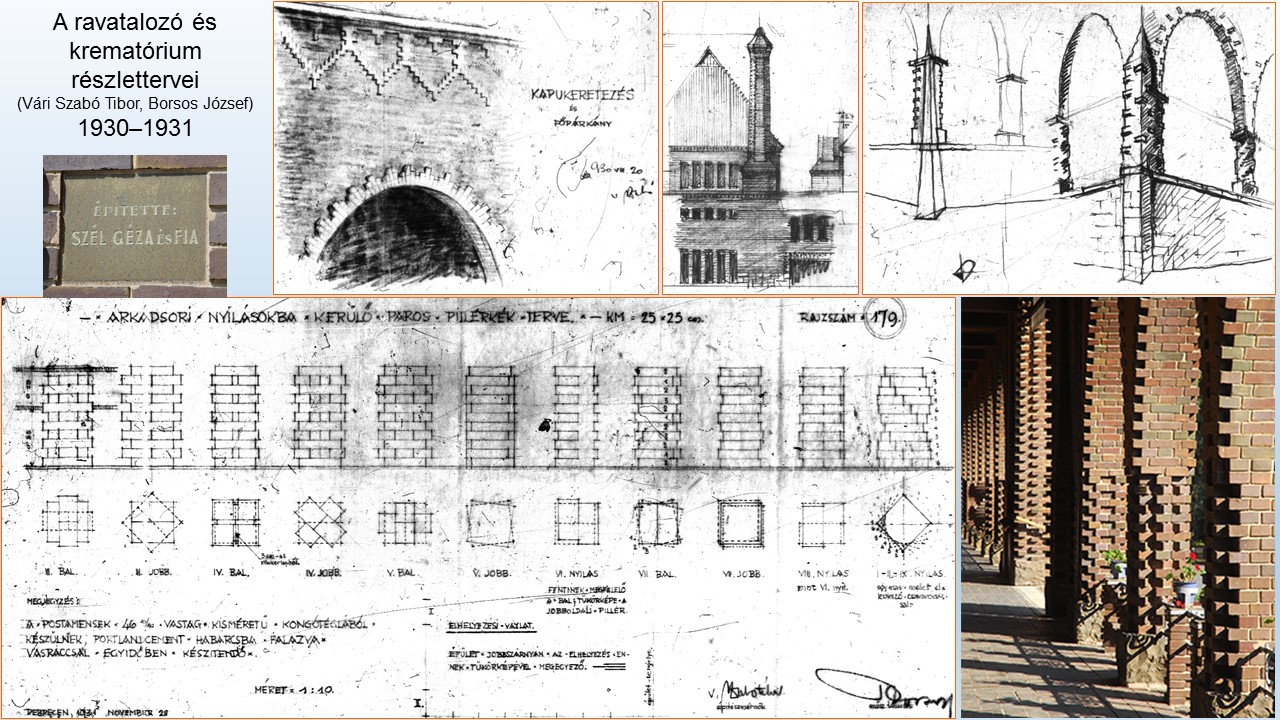
(edited: Papp József)
The well thought-out exterior and interior decorations of the forest cemetery garden suggest the character of a public cemetery. On the central and outer gables of the funeral building is a bronze replica of the bull's-head drinking cup from the golden relic of Nagyszentmiklós (the figure has been known as a symbol of national mourning since 1900, when it decorated the funeral of Mihály Munkácsy).
(photo: Papp József)
The earliest works of art in the Cemetery were commissioned from local or expatriate artists. The frescoes and glass mosaics on the high ground floor of the main building, in the eastern (No. 1) funeral parlour, were painted by Jenő Haranghy, and in the middle (No. 2) by Jr. János Kovács and László Holló in the west (no. 3).
The stained glass windows in the north (no. 4) ceremony room are the work of Klára B. Kokass.The sgraffitos on the main arcade of the funeral hall is by Oszvald Toroczkay. The sgraffito on the main arcade of the funeral hall is by Oszvald Toroczkay. The glass mosaics were made by Sándor Palka.The Hungarian patterned joinery of the buildings was made by the workshops of "Bessenyei and Weisz", "Red and Szabó" and Lajos Nagy. The ornate locksmith work of the building also praises the talent of the Debrecen masters László Szalkai and Imre Király.
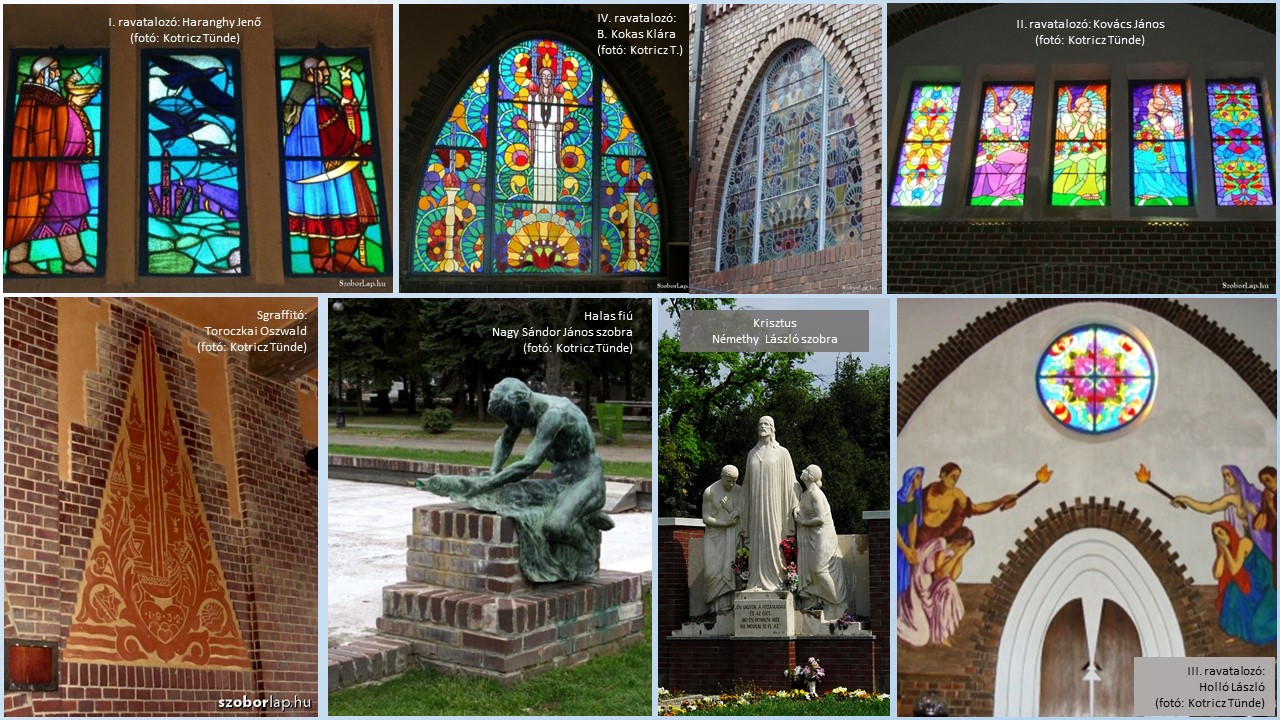
(photo: Kotricz Tünde, Papp József)
The three-figure statue of Christ between the main doors is the work of László Némethy, while the bronze statue of the "Fish Boy" in the pond in front of the funeral home is the work of János Sándor Nagy.
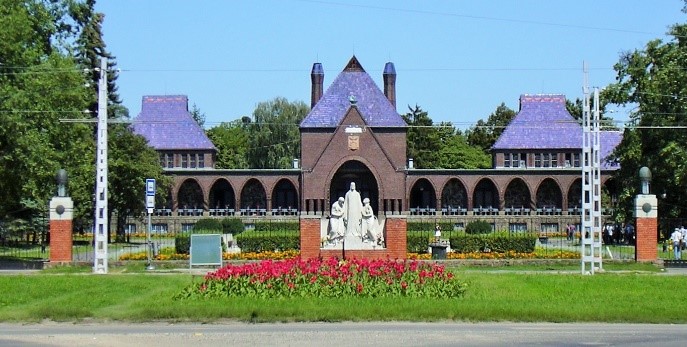
(photo: Papp József)
In the areas surrounding the funeral parlour, in April 1932, the 56 graves on both sides were created, where the separation was made with runner roses and the background planted with lime trees. On the outer edge of the oval space surrounding the main building, a 12-metre wide grass strip was created around the paved road, with flower beds and pine and evergreen plants. Behind the strip, the backdrop for the ornamental graves was created with flowering shrubs on the right and left, pines on the north and Canadian poplars. To the east of the main entrance, a larger evergreen area was created with evergreens, tulips and pines, creating 23 separate family burial plots in this 'privileged board'.
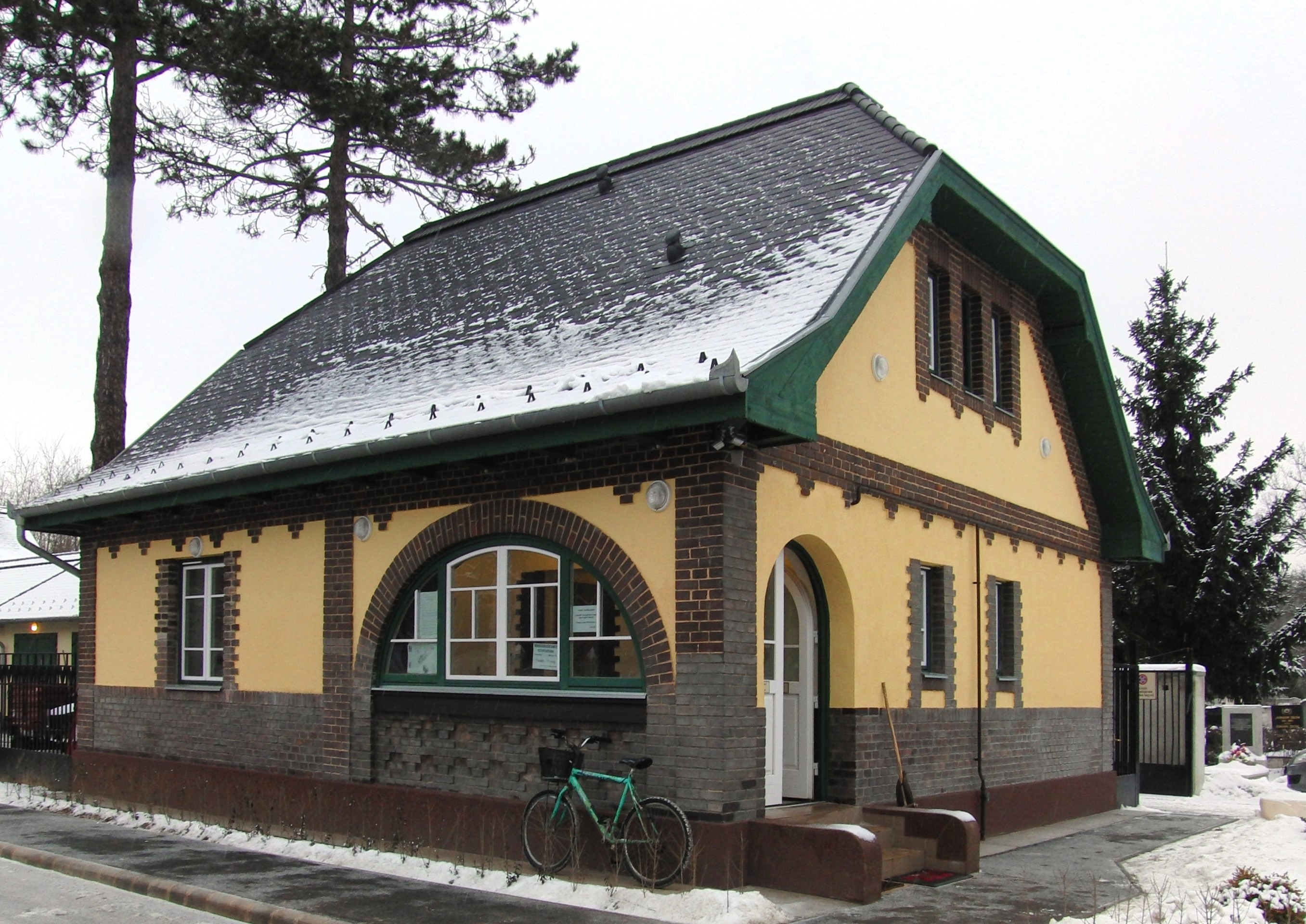
(photo: Papp József)
The crematorium in the basement of the mortuary building was also completed by the time of the opening, but due to delays in obtaining permits from the authorities, it was only two decades later, in 1951, that the crematorium could be put into operation, and in 1963 a new crematorium was built.
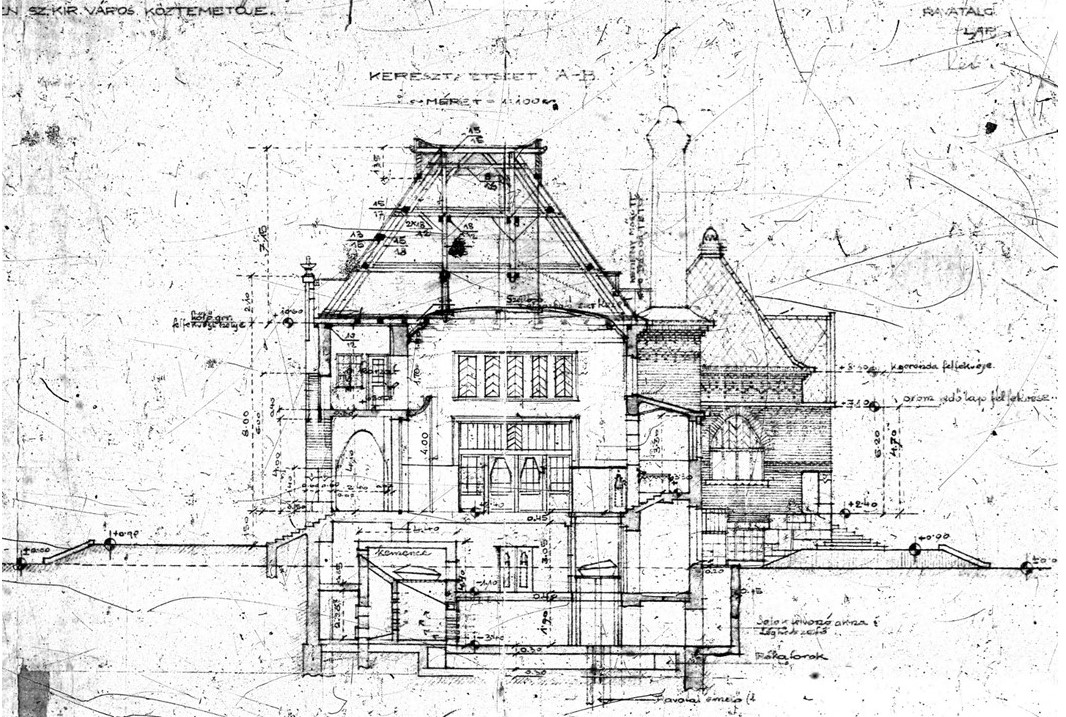
A couple of decades later, to meet the growing demand, the 3000-seat urn hall designed by architects János Szabó and Bernát Boruzs was completed in 1972. The columbarium's stained glass windows are the work of artist Tibor Duray.
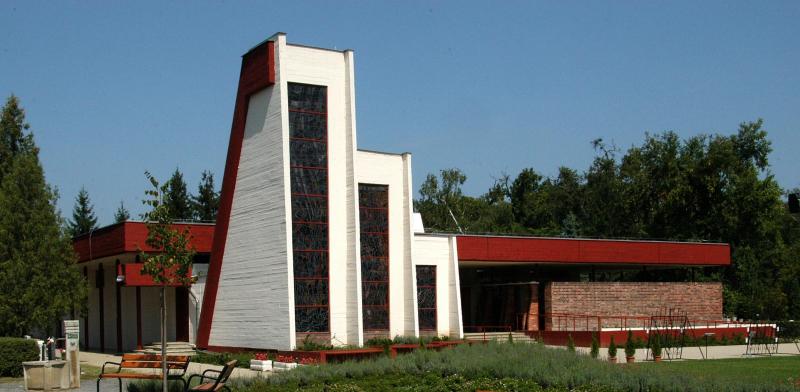
(foto: Rácz Zoltán)
(photo: Rácz Zoltán)
The complete renovation of the facility, designed by architect Zoltán Rácz, was completed in 2007. In the area in front of the building complex, Sára Dobos designed the ash-spraying shrine for the inauguration in 2011.
The ecumenical chapel of the cemetery was built in memory of the writer-journalist János Juhani Nagy by his parents. The building, consecrated in 2011, was designed by architect Ferenc Gellér.

(mapio.net)
Half a year after the opening of the Cemetery, there were data on 780 adult and 670 children's graves. Including those transferred from the ancient religious cemetery, the total had risen to 2305 by November 1933 and 4407 by July 1934. In the closed old cemeteries, complete liquidation began after a ompulsory 30-year dormancy period. After the known relatives and interested parties of those buried there had been informed, the remains were brought to the Public Cemetery, partly by individual reburial, and in larger numbers by mass burial.
Celebrities buried elsewhere, outstanding personalities of public life, science and art were reburied in honorary plots designated for them, at the initiative of the city authorities or institutions and organisations. For example, during the liquidation of the former Kossuth Street cemetery, Mihály Fazekas was exhumed on 19 October 1961, and he and Samuel Diószegi were buried in the 6th Grove of the Köztemető, with their tombstones, which had been inaugurated in 1904, placed on their mounds.
(photo: Papp József)
In the following years, Péter Balogh, the Reformed Bishop, József Erdélyi, Imre Csécsi Nagy and Pál Kovács, professors at the college, were buried in this way. Mihály Tóth Könyves, Isaiah of Buda, Áron Kiss Hegymegi, Dániel Ercsei, Pál Beregszászi, Dániel Csányi, György Csipkés of Komárom were also buried at this time.
(photo: Papp József)
In the protected plots of the honorary graves are the well-kept graves of the outstanding persons who died in 1932 and afterwards, of those who had a significant life in the socio-political life of the nation and Debrecen, in the sciences, in art, in sports, in other sectors of public life. The graves of the city's leading figures in education, culture, religion and the arts, including the architect József Borsos and the head gardener Ferenc Pohl, who designed the cemetery, are among the graves of those who rest there.
(photo: Papp József)
Also protected are tombs of artistic value, including works relocated from dismantled cemeteries, such as the Sestina and Svetits tombs.
(photo: Papp József)
The cemetery has had military graves arranged side by side since the beginning of the Second World War. We know of 12 Hungarian soldiers buried in 1941 and 48 in 1942 in Plate XIV/B, and from the end of that year and a further 62 in 1943 in Plate XVI. A total of 898 civilian and soldier victims of the 1944 aerial bombardments were mostly buried in the Bombed Graveyard Plot XV/3, many victims were placed in family graves, and some were transported from Debrecen. Hungarian soldiers who died in the battles for the possession of the outskirts of the city were also received in the Graveyard of the Bombed. After 19 October, the day of the victory of the Soviet troops, only some of the barely identifiable Hungarian heroes were buried here, some of them in the now defunct plots XIX/1, XIX/2 and XIX/3 of the free cemeteries.
(http://dkth.erda.hu/hu)
The Hungarian military heroes temporarily buried in public squares or elsewhere were laid to rest in the Hungarian Heroes' Plaque XXII. It also received the 322 prisoners of war who returned from the Soviet Union and died between 4 January 1945 and 9 January 1949 in an aid station or hospital in Debrecen.
(http://dkth.erda.hu/hu)
Another 62 Hungarian and 142 German prisoners of war were buried - for unknown reasons - in the Soviet military mass grave XVI/A, but there were also German soldiers in the grave yard of the XV/3 Bombed, and in 1945 28 German prisoners of war. (They and the Germans buried in other graves were transferred to the German-Hungarian military cemetery in Budaörs in 1997.)
(http://dkth.erda.hu/hu)
The 31 Romanian soldiers of the World War are buried in a mass grave marked with a coat of arms in Plot IX, and Romanian soldiers are buried in Plates XIX/2 and XIX/4, which no longer exist, and in Soviet Plate XVI/A. In the Debrecen Public Cemetery, which has the distinction of being an international military cemetery, heroes from four countries, including the largest number of heroes of the Soviet Red Army, are buried. Of the 1358 Soviet soldiers who died as a result of the fighting in the city's surroundings and for other reasons, 1358 are buried here in individual and mass graves.
(photo: Papp József)
The Soviet plot XVI/A is marked by the huge obelisk, which was transported from Debrecen's main square to the Köztenkemető in the 1960s, together with the remains of the 22 soldiers who rested underneath. The memorial plaques in their graveyard bear the names of thousands of Soviet heroes, including the names of the female nursing staff of Debrecen's hospitals, and even some of the deceased children.
(photo: Papp József)
"The Municipality of the City of Debrecen defines the protected graves of the public cemetery by an Assembly Regulation.Protected are the national gravesites of the NÖRI (National Heritage Institute) of Debrecen, the honorary gravesites donated by the mayor and the public gravesites, as well as the gravesites of notable persons/graves, as decided by the General Assembly's Committee for Public Affairs, and in addition to these, the so-called war graves located in war plots and scattered throughout the cemetery."